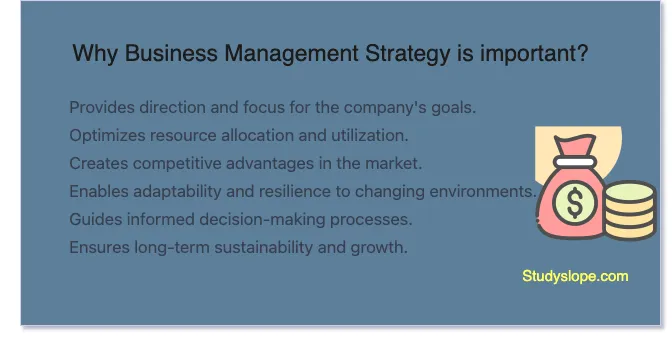Table of Contents
Business Management Strategy Overview
To run a business successfully, you need a well-thought-out plan that includes many things, from setting goals and targets to carrying out day-to-day tasks. A successful business management strategy includes meticulous planning, making the best use of resources, encouraging new ideas, knowing how the market works, and quickly responding to changes.
Using available tools and frameworks to make a roadmap that connects the organisation’s goal with steps that can be taken, and encouraging a culture of adaptability and continuous improvement are all important parts of this process. At the end of the day, a good plan not only gets the business through tough times but also sets it up to do well in a changing and competitive environment.
Business management strategy comprise a variety of ways to optimize operations, achieve goals, and maintain growth. They entail the planning, organising, leading, and regulating of a company’s resources and activities to achieve efficiency, innovation, and profitability.
As you read through this blog, you will get knowledge regarding business management strategies, the significance of strategic business planning, and the steps necessary to create a business development strategy for your organisation.
What is a Business Management Strategy?
A business management strategy is a detailed plan or collection of procedures meant to help a company accomplish specified goals and objectives. It entails the methodical coordination of resources, processes, and people in order to optimize performance, stimulate growth, and sustain a market competitive advantage.
A business management plan systematically finds and selects solutions that provide value to a company. It aims to define the organization’s growth strategy and the policies and management plans needed to maximize the value of its resources.
A business management strategy has the following objectives:
- Profit maximization: it means increasing sources of income and making operations as efficient as possible in order to make the most money.
- Market leadership: This means becoming the market leader through new ideas, better goods or services, or better customer service.
- Operational Excellence: Streamlining processes and resource allocation to gain optimal efficiency and productivity.
- Customer Satisfaction and Loyalty: Giving people great value, making them loyal, and keeping a strong customer base.
- Strategic Growth: Looking for long-term ways to grow, like expanding your market, making your products more varied, or forming strategic relationships.
- Risk management: it is the process of finding and reducing risks in order to keep a business running and avoid problems.
- Employee Engagement and Development: Creating a positive work environment, giving workers the tools they need to do their jobs, and encouraging them to keep learning and growing.
- Sustainability and Social Responsibility: Making sure that businesses are environmentally and socially responsible while also making sure they will last and have a good effect on society.
How to Develop a Business Management Strategy
An effective business management strategy should have a clear goal: either supporting the company’s current plan or coming up with a new one. The following steps can help to develop a business management strategy to manage a business effectively and smoothly.
- Choose the core competency of your business. Figuring out what your company does best is the first thing you should do when making a business management plan. To make your business stand out, you need to take this step. Examples of core competencies include supply chain management, product design, customer relationship management, etc.
- Find the business niche for your company. Your main niche is the main thing your business does. Finding the main area for your business will help you set goals for it.
- Figure out who the target audience is. Businesses can do better if they know a little about their customers. People who sell things for kids, for example, are likely to do well with younger people.
- Determine how much your product Cost. Yes, it does depend on how much people are willing to pay. One example is that stores that sell high-end goods are likely to charge more than stores that sell cheap goods.
- Find out the best way to get in touch with your audience. Some brands might be ready to spend more on ads than others, for example.
- Determine your marketing mix. The marketing mix includes the products and prices that a business offers, as well as the ways that those products are sold and the way that the business talks to its customers. A well-balanced marketing mix can help a business stay competitive in the market.
- Find out how your business will grow. Businesses need to figure out how to grow in the long term in this step. Some companies may choose to improve and add to the services they already offer, while others may decide to change how they work by adding new services.
- Determine your financial plan. Lastly, companies need to plan how they will pay for their growth. For example, financial decisions rest a lot on how much money the development needs. The economic plan should also match the overall business strategy.
Why Business Management Strategy is important?
A business management strategy is important because it helps organisations match their goals with plans they can carry out. It gives the company a blueprint for making decisions, allocating resources, and operating its business, making sure that everyone works together to reach their objectives.
Businesses can respond to changing market conditions, take advantage of opportunities, lower risks, and stay competitive when they have a well-thought-out plan. It encourages efficiency, innovation, and adaptability, which helps businesses deal with complexities, make smart decisions, and maintain long-term success in a world that is always growing more competitive every day.

